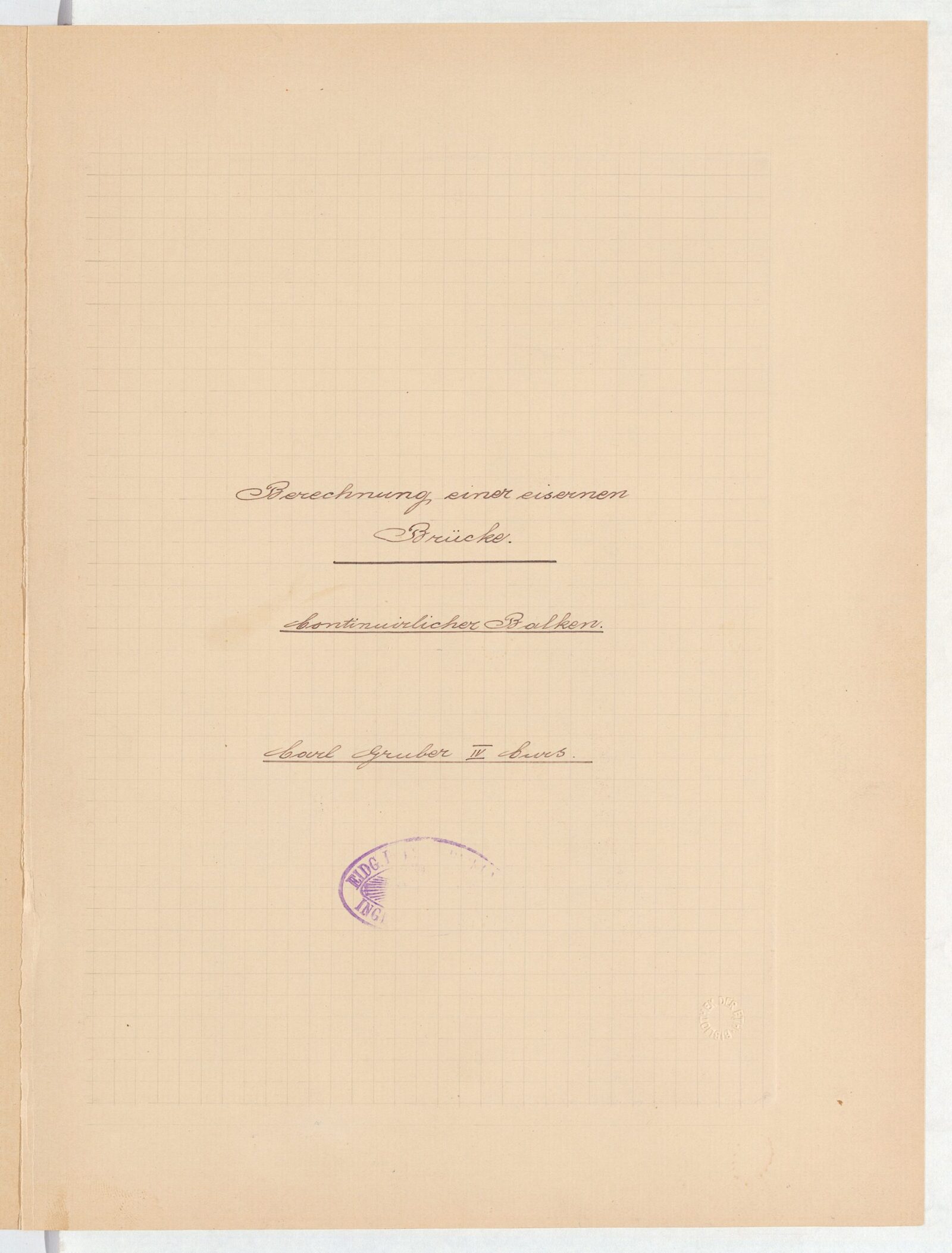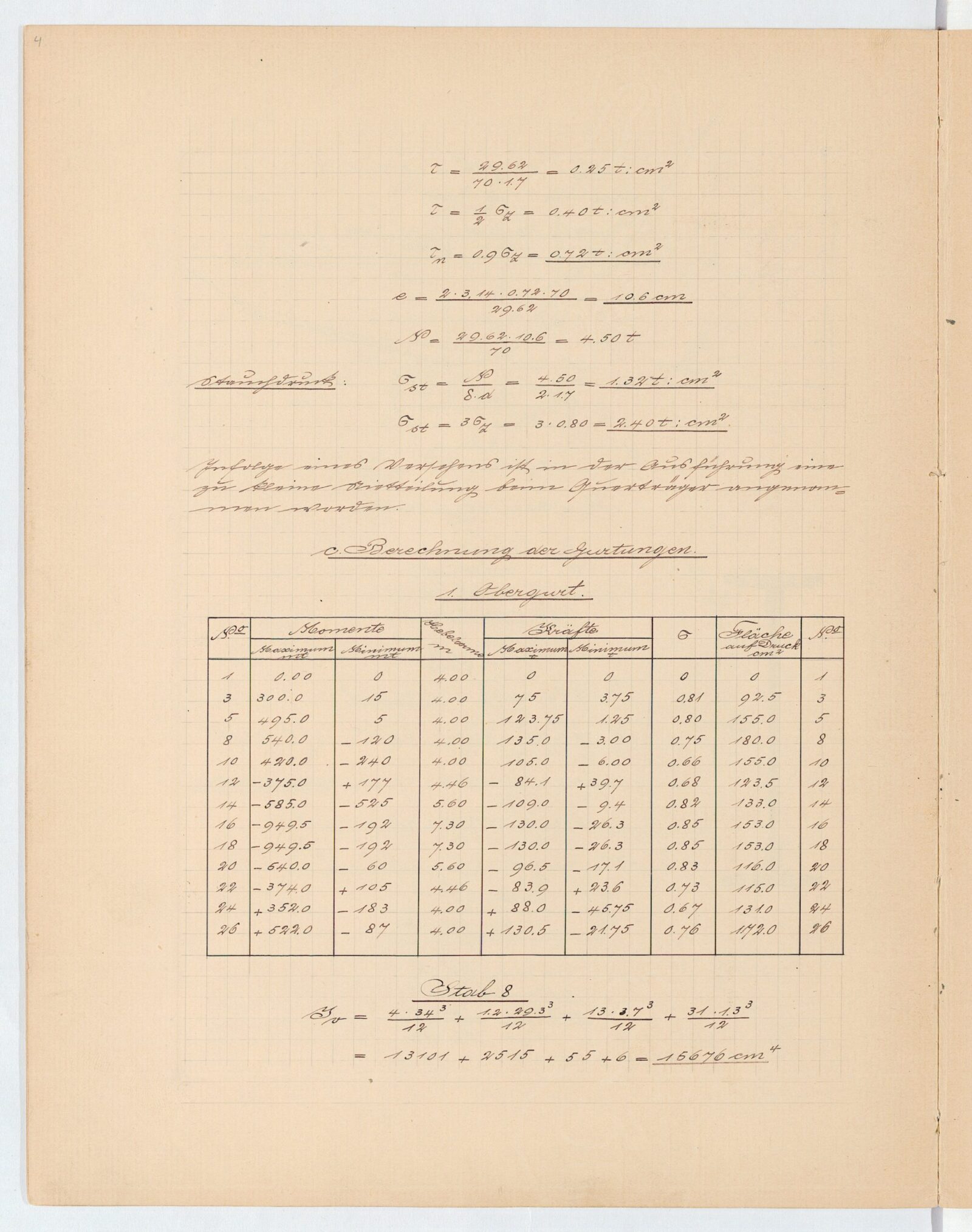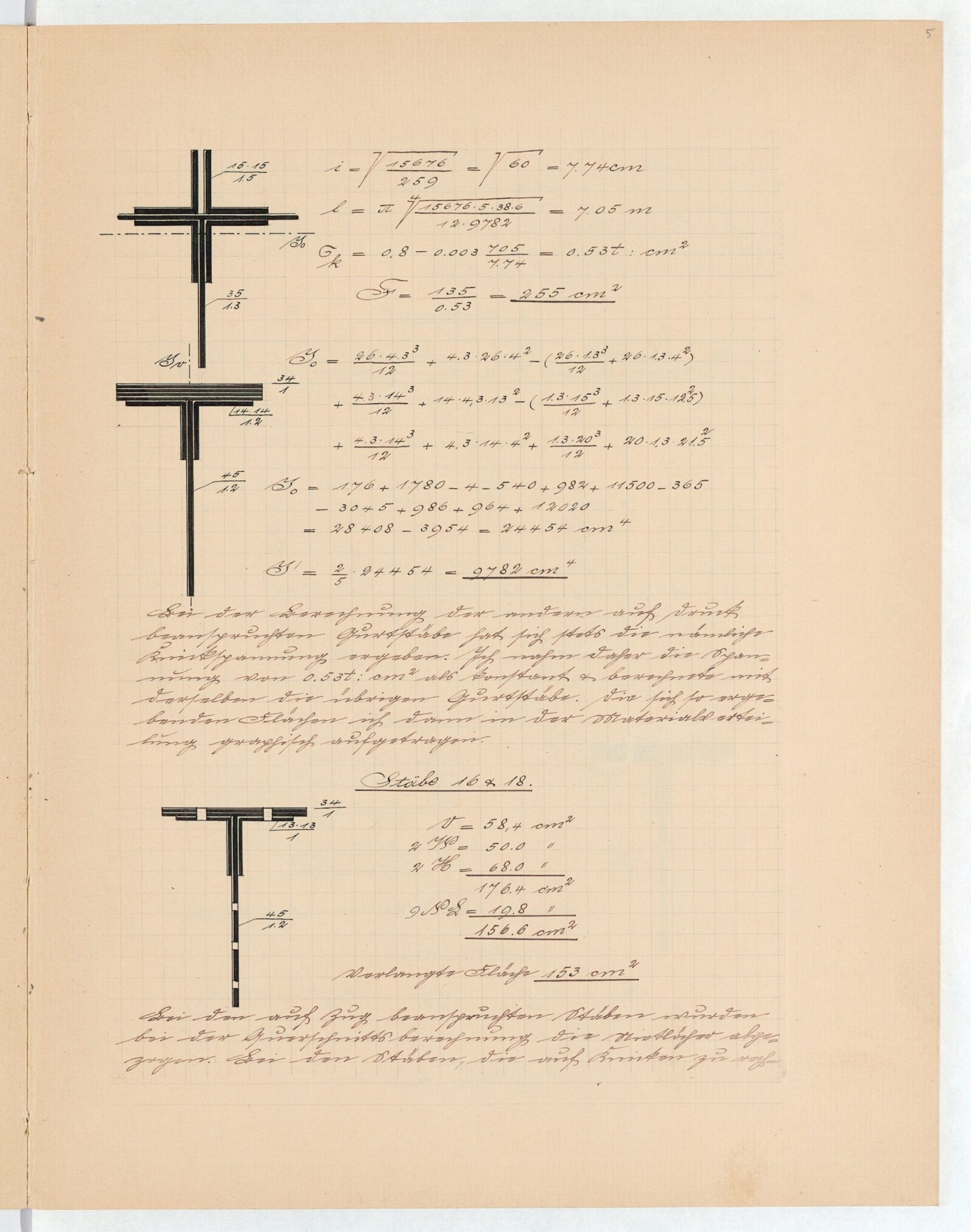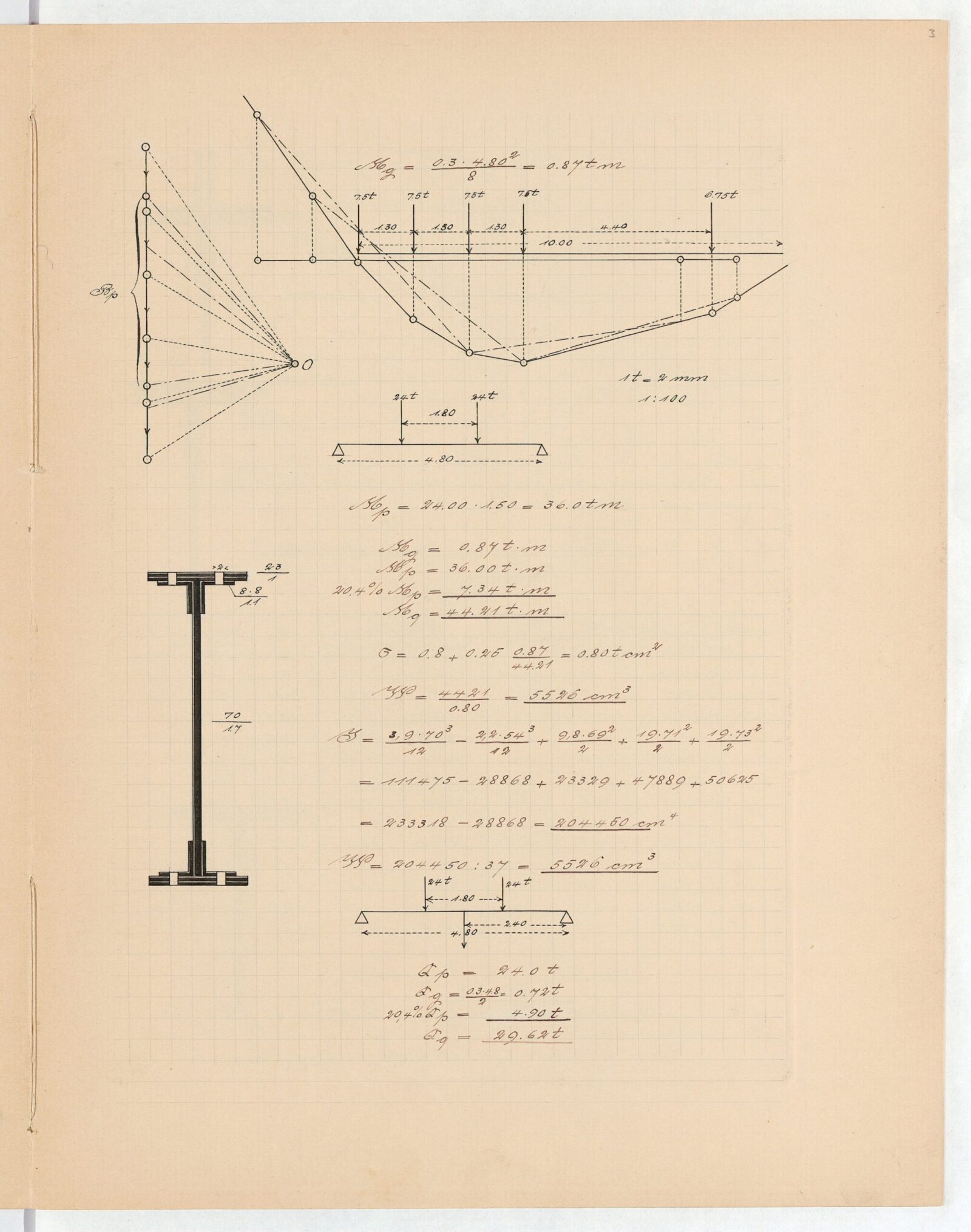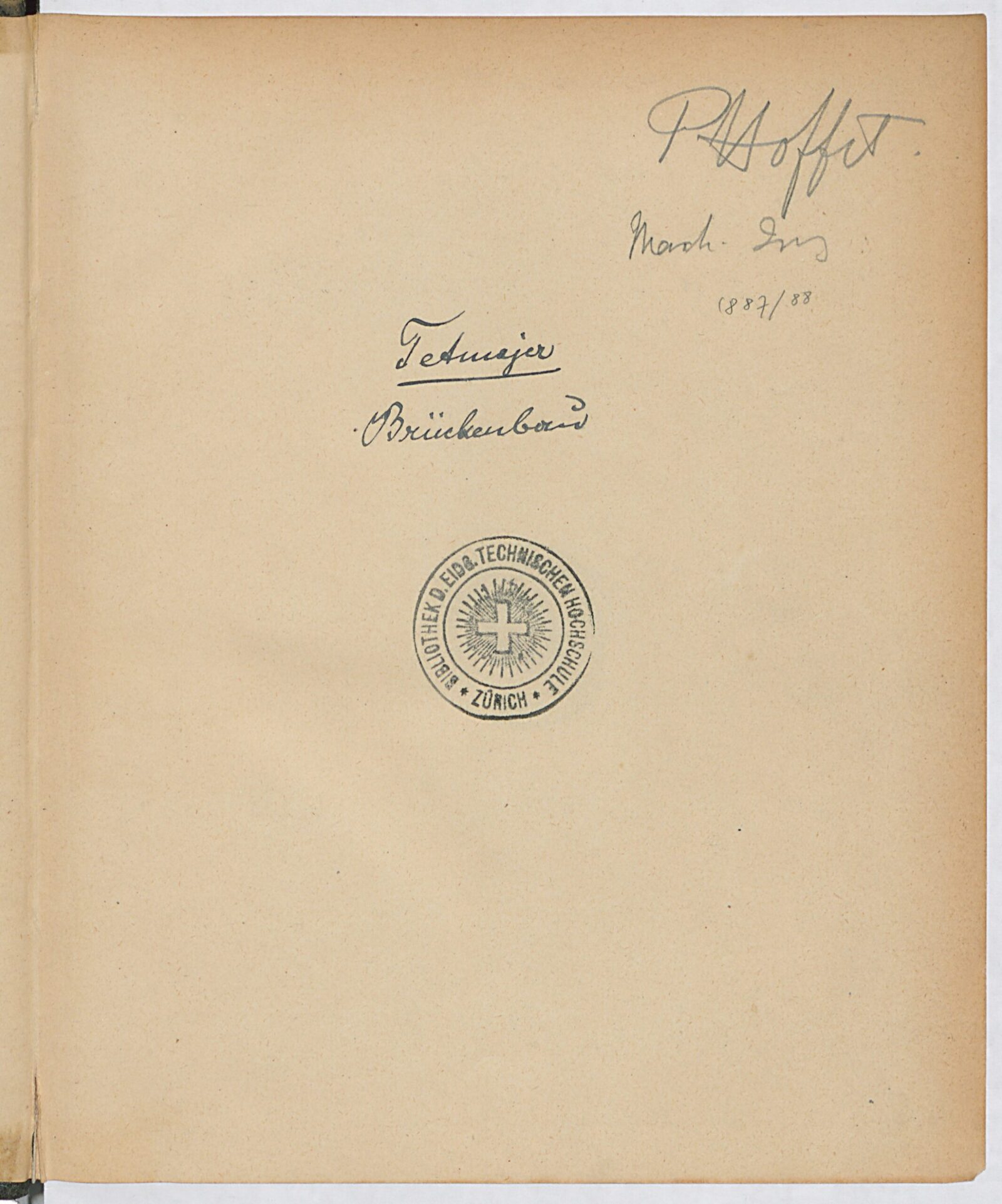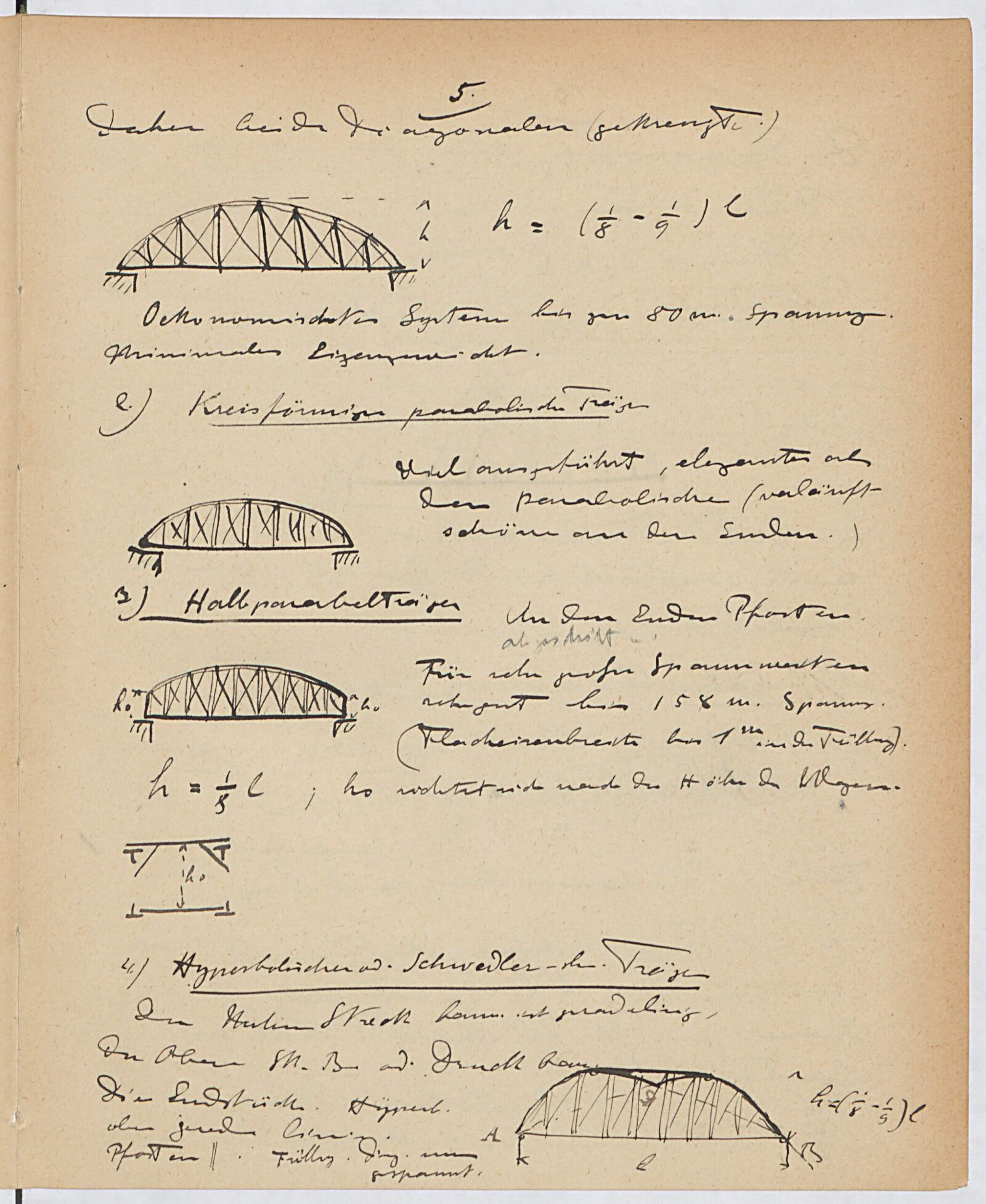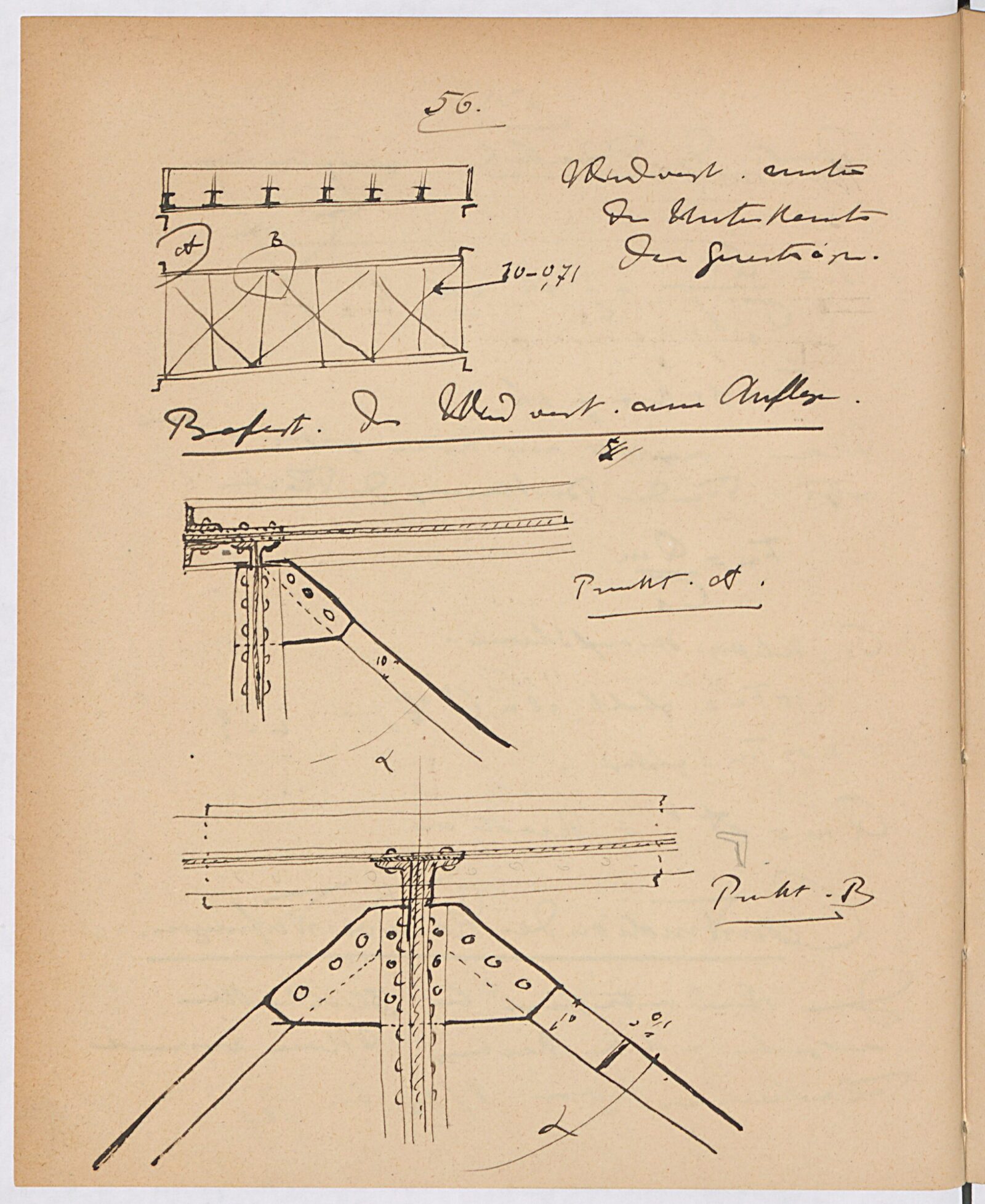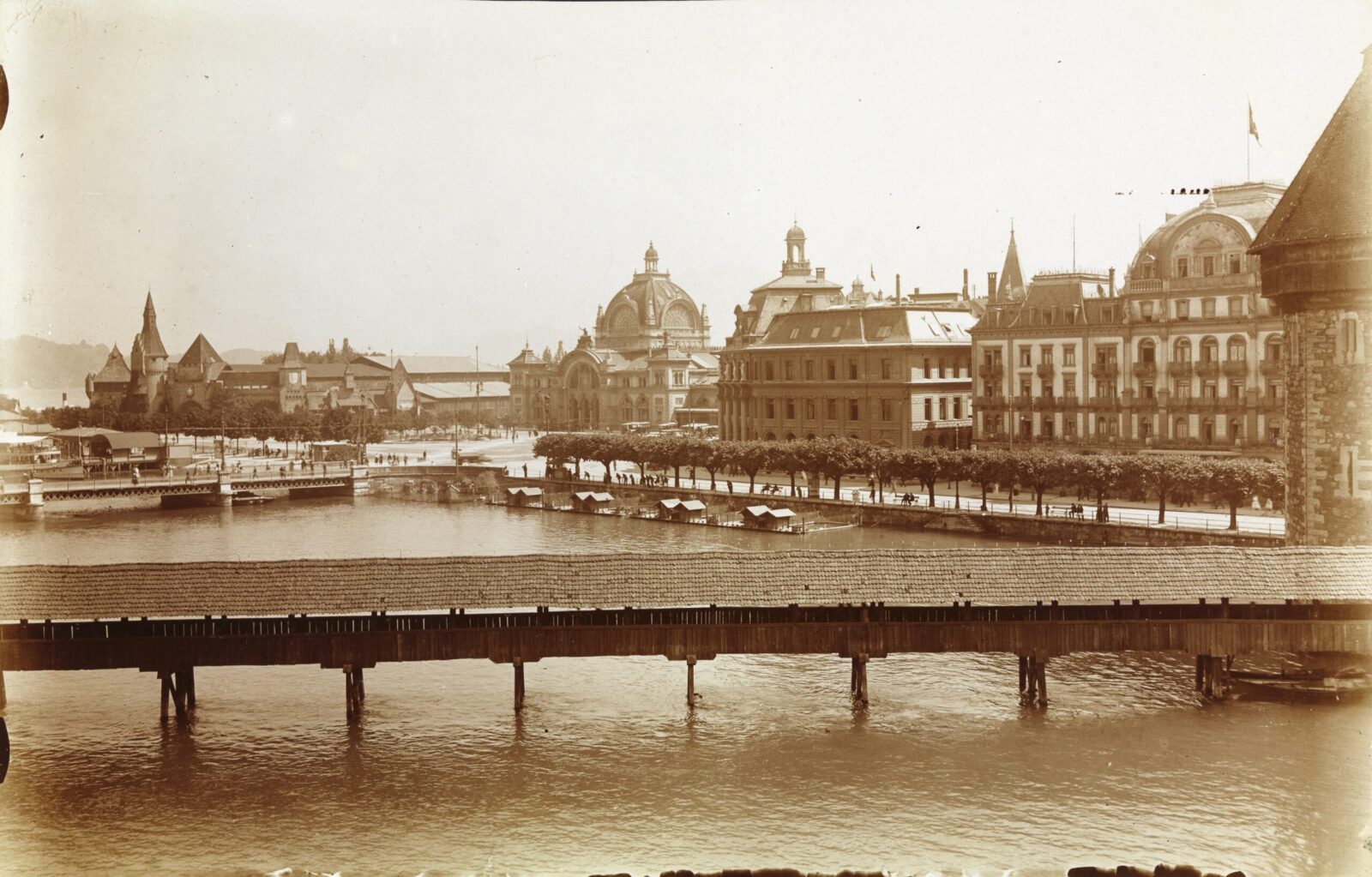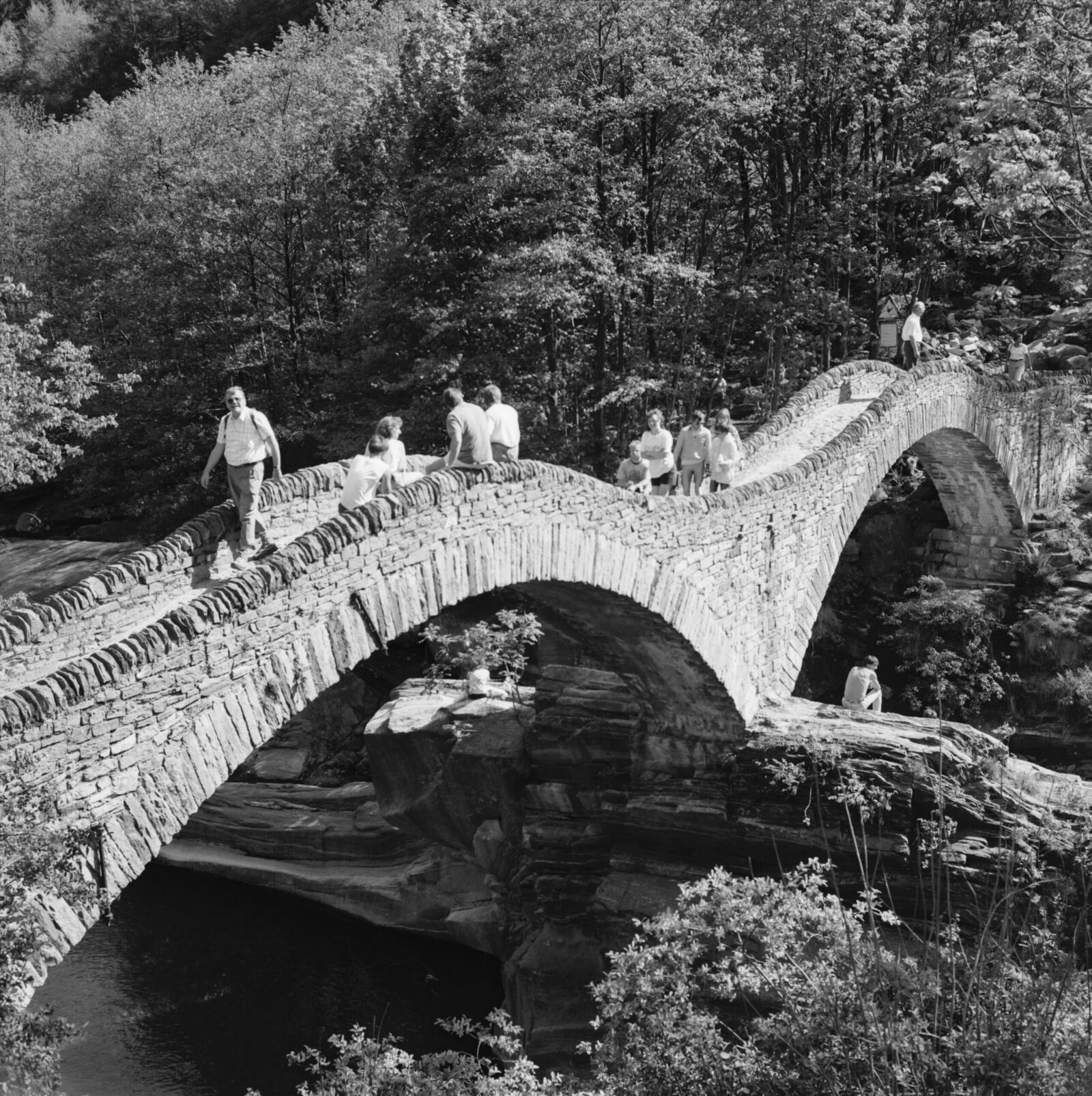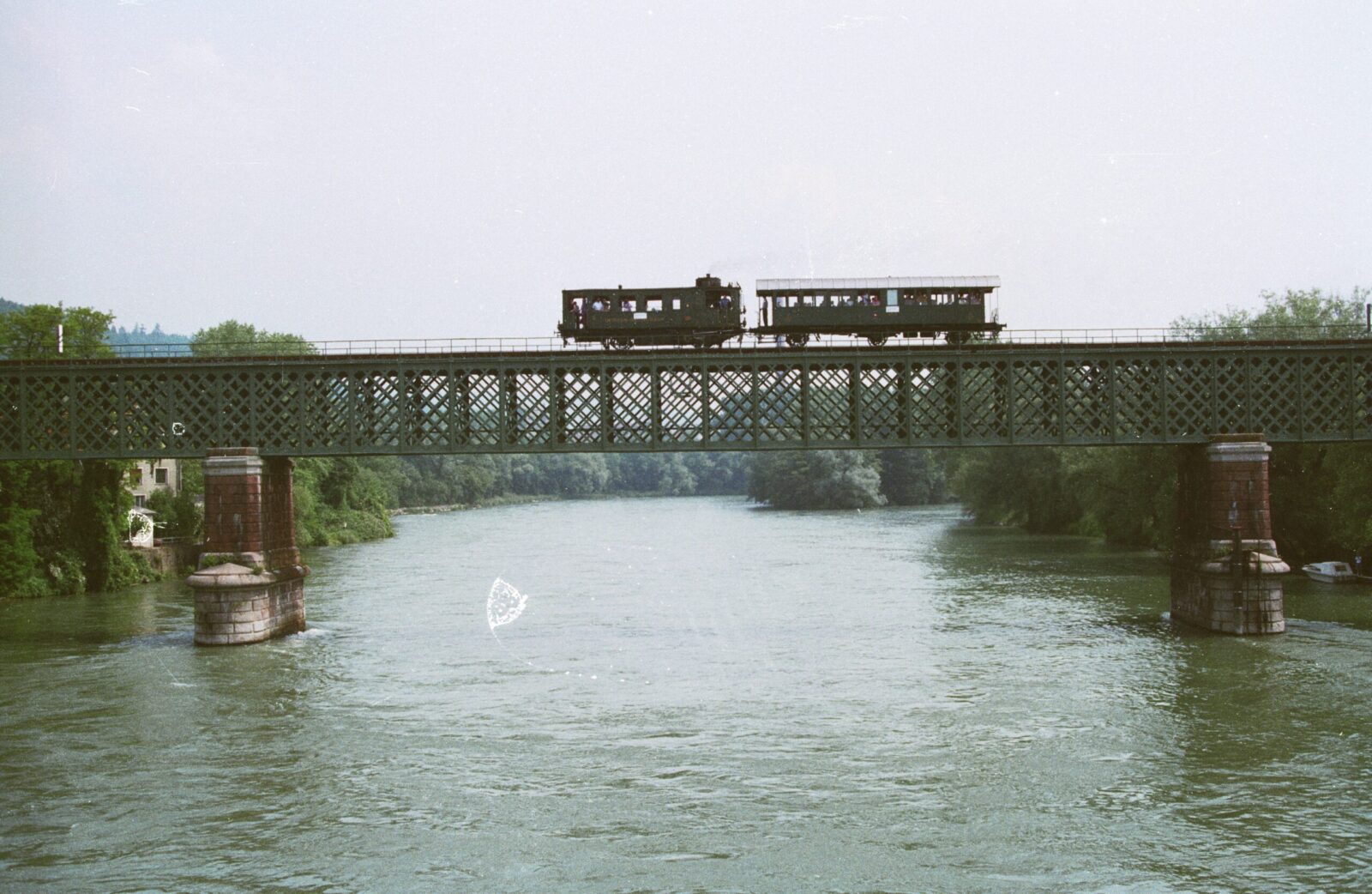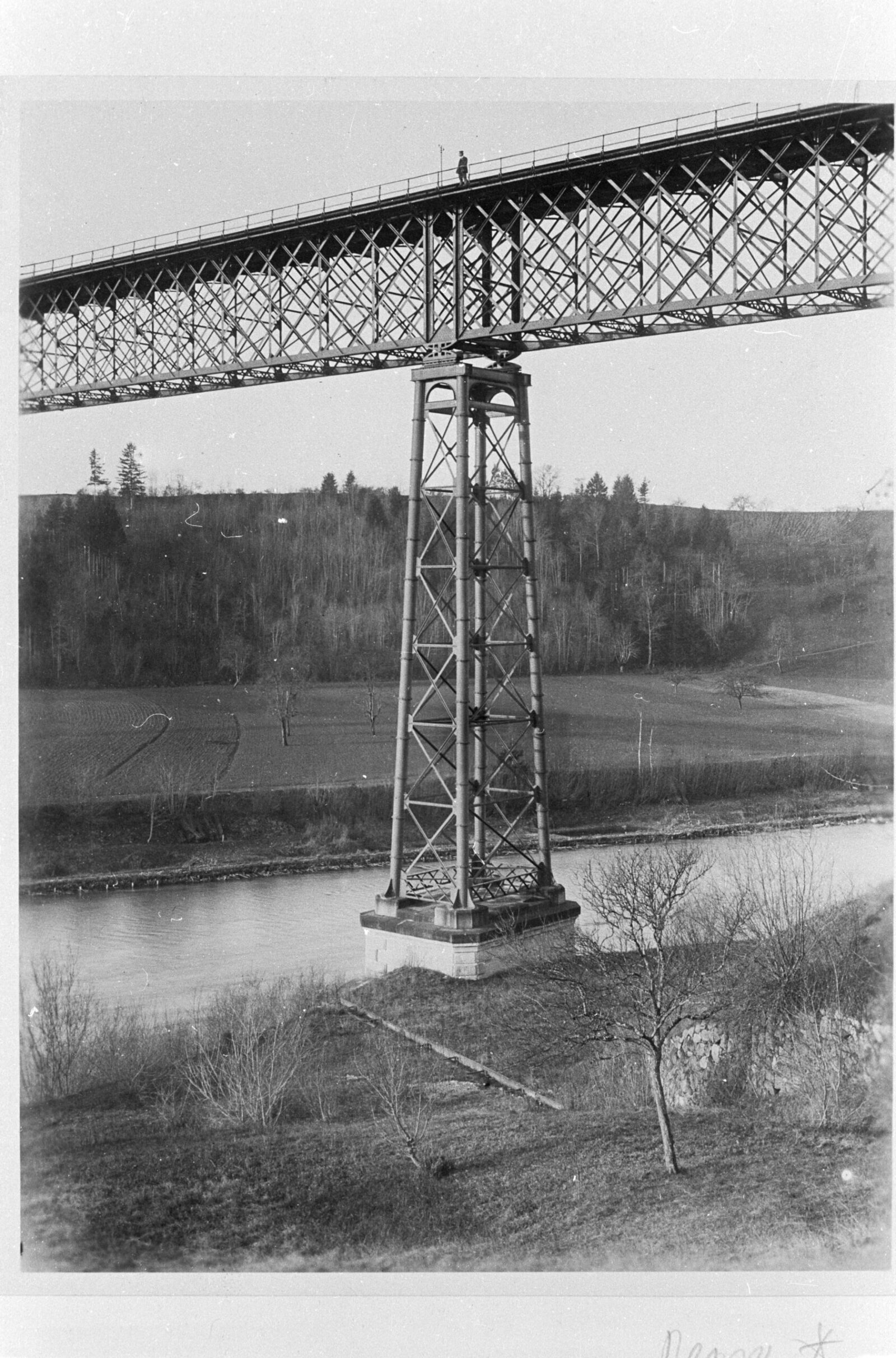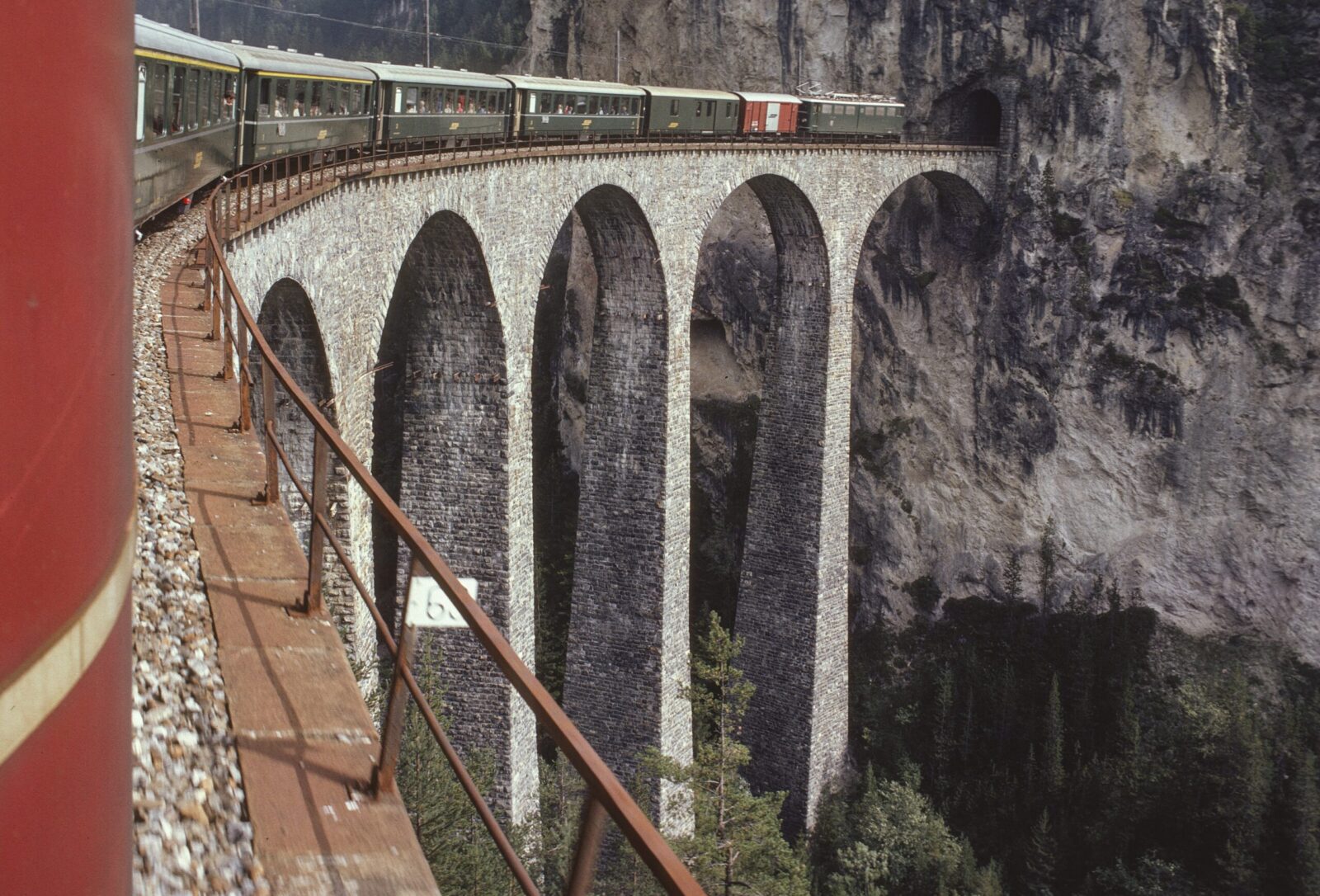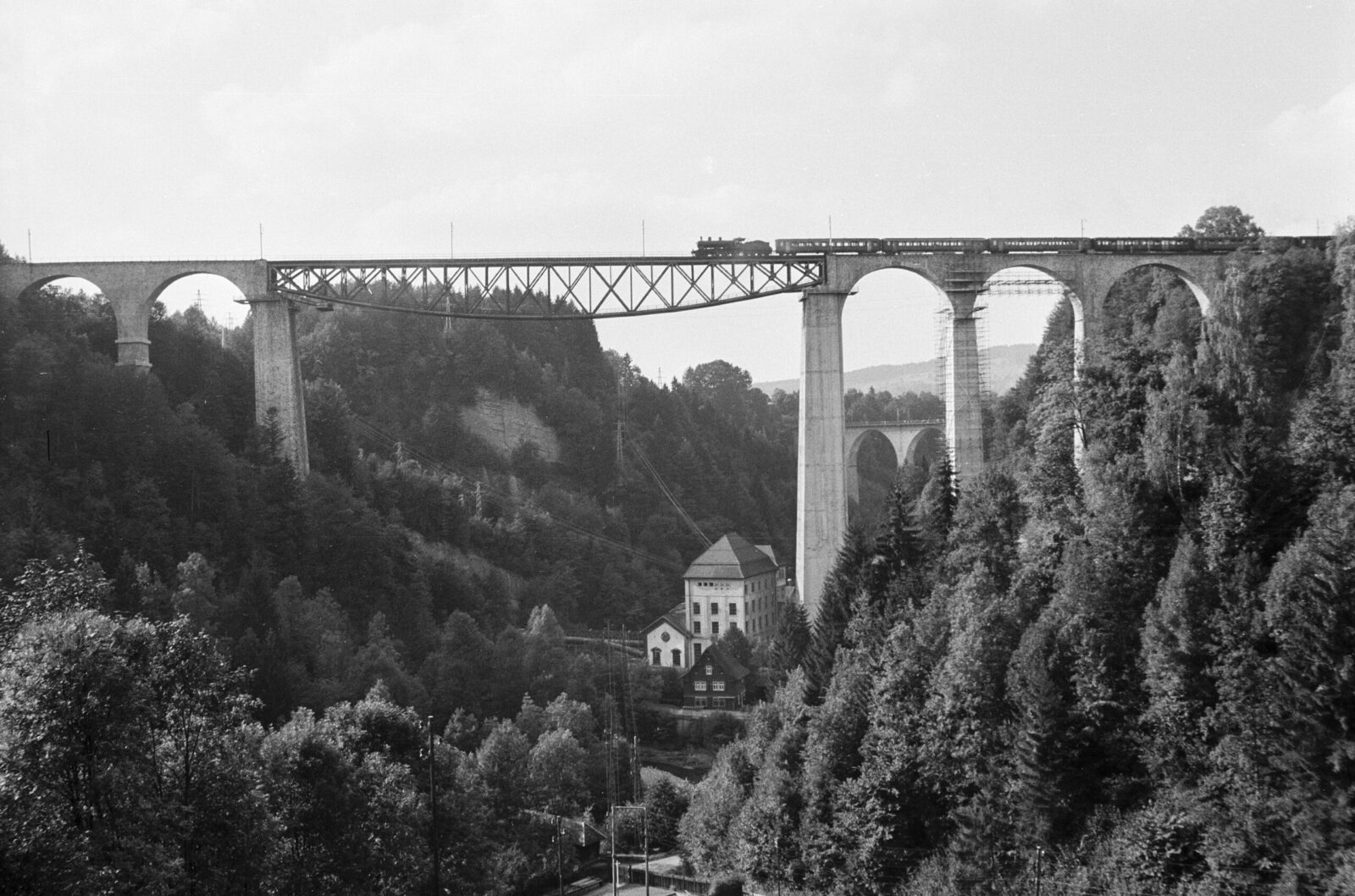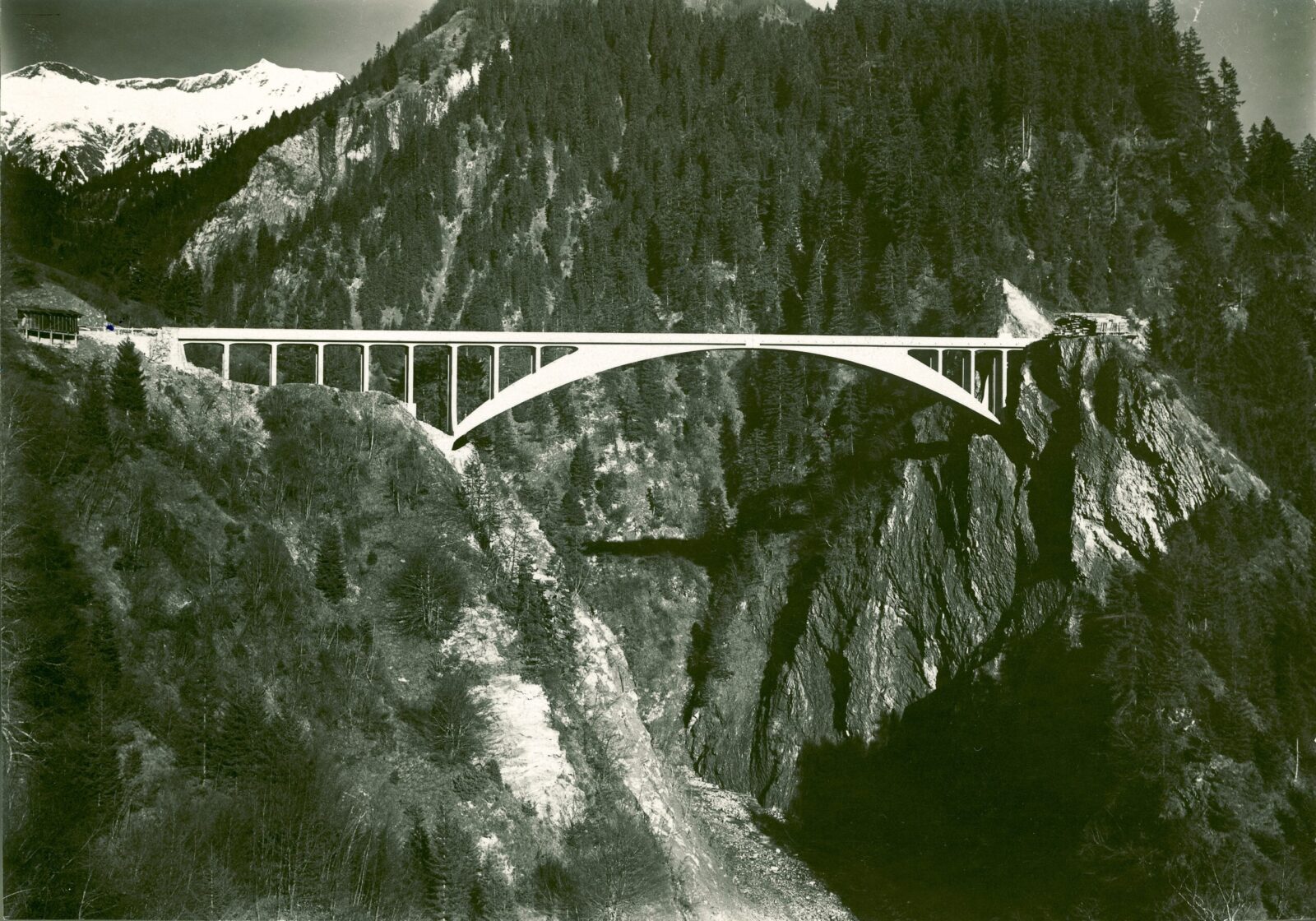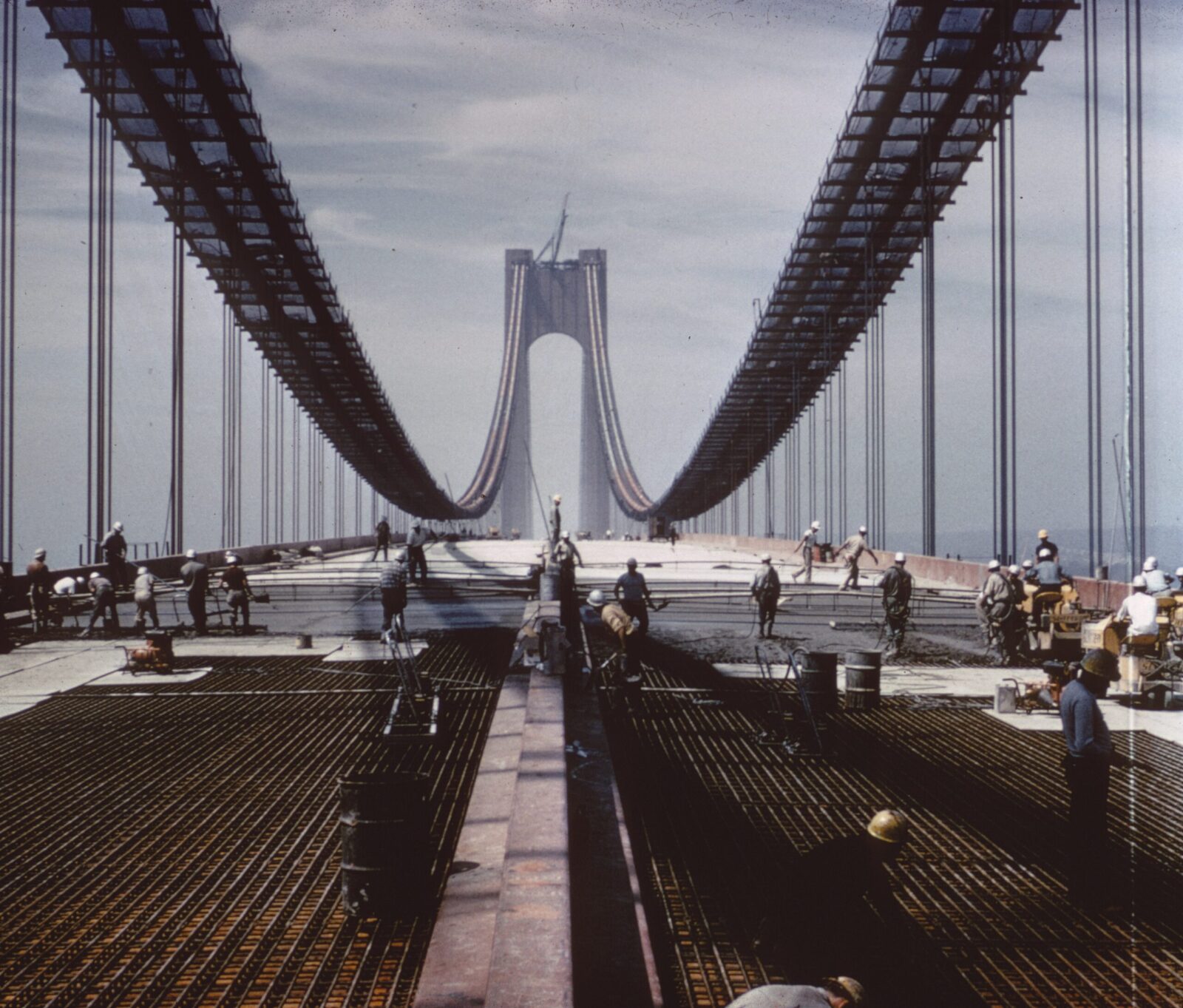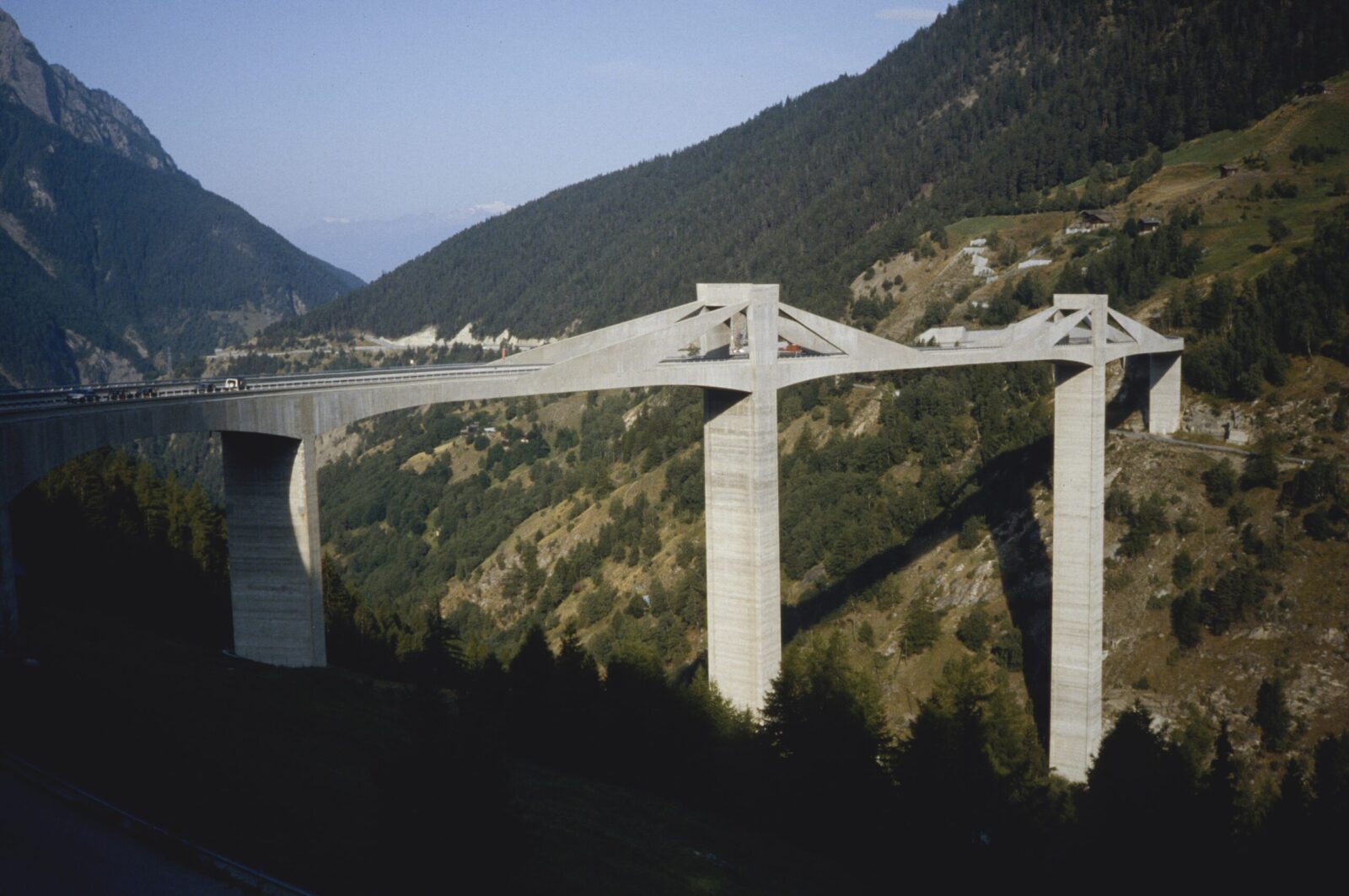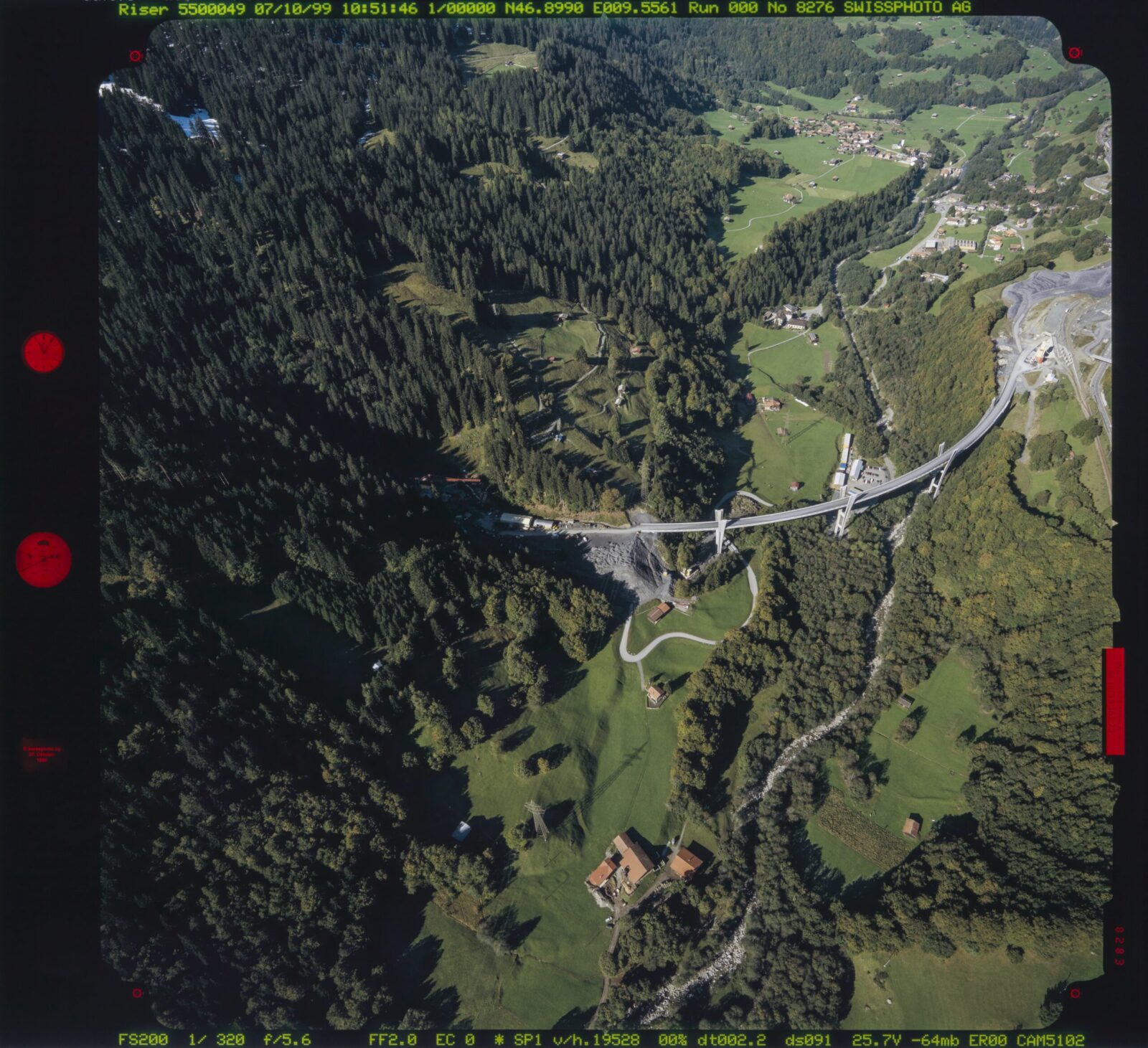Across rivers and gorges
Switzerland and its bridge-builders
Switzerland is a country of bridges: more than 40,000 bridges 1 span rivers and gorges, connect valley sides and people and open up the remotest of mountain regions. Forms and materials are very diverse. They range from medieval stone-arch bridges to beam bridges made of cast iron to modern highway viaducts made of reinforced concrete. “People in other countries are amazed by the bridges in Switzerland,” says Walter Kaufmann, Professor of Concrete Structures and Bridge Design at ETH Zurich. Admittedly, due to the limits of the country’s topography, Switzerland is never going to win prizes for the biggest, highest or longest bridge in the world: “At least among the newer bridges, there are hardly any that can be considered landmarks.” Instead, Swiss bridges are known for combining efficiency with aesthetics and careful design. By employing a great deal of expert knowledge, creativity and courage, Swiss bridge-builders have created gems worth discovering.
Modern bridge-building in Switzerland experienced a boom beginning in the middle of the 19th century in the course of industrialisation. The transport of goods and people increased dramatically, and a growing number of roads and train lines were created. “The train was an important driver of modern bridge-building,” says Kaufmann. That was because bridges could no longer be built on the valley floor, as had previously been the case. Railway lines had to avoid being too steep and curvy, which is why they were laid high above the valleys. This meant that longer distances had to be spanned, which traditional stone-arch bridges were no longer able to accomplish. New technical solutions were needed.
From craft to science
Civil engineers from the young Federal Polytechnic Institute – known today as ETH – played an important role in developing new building principles. ETH was founded in 1855 expressly with the aim of also training “technicians for roadway, railway, hydraulic and bridge engineering”. 2 An important figure was Karl Culmann, the first professor of engineering sciences, who was originally from Germany and had worked as a railway engineer for the Bavarian civil service.
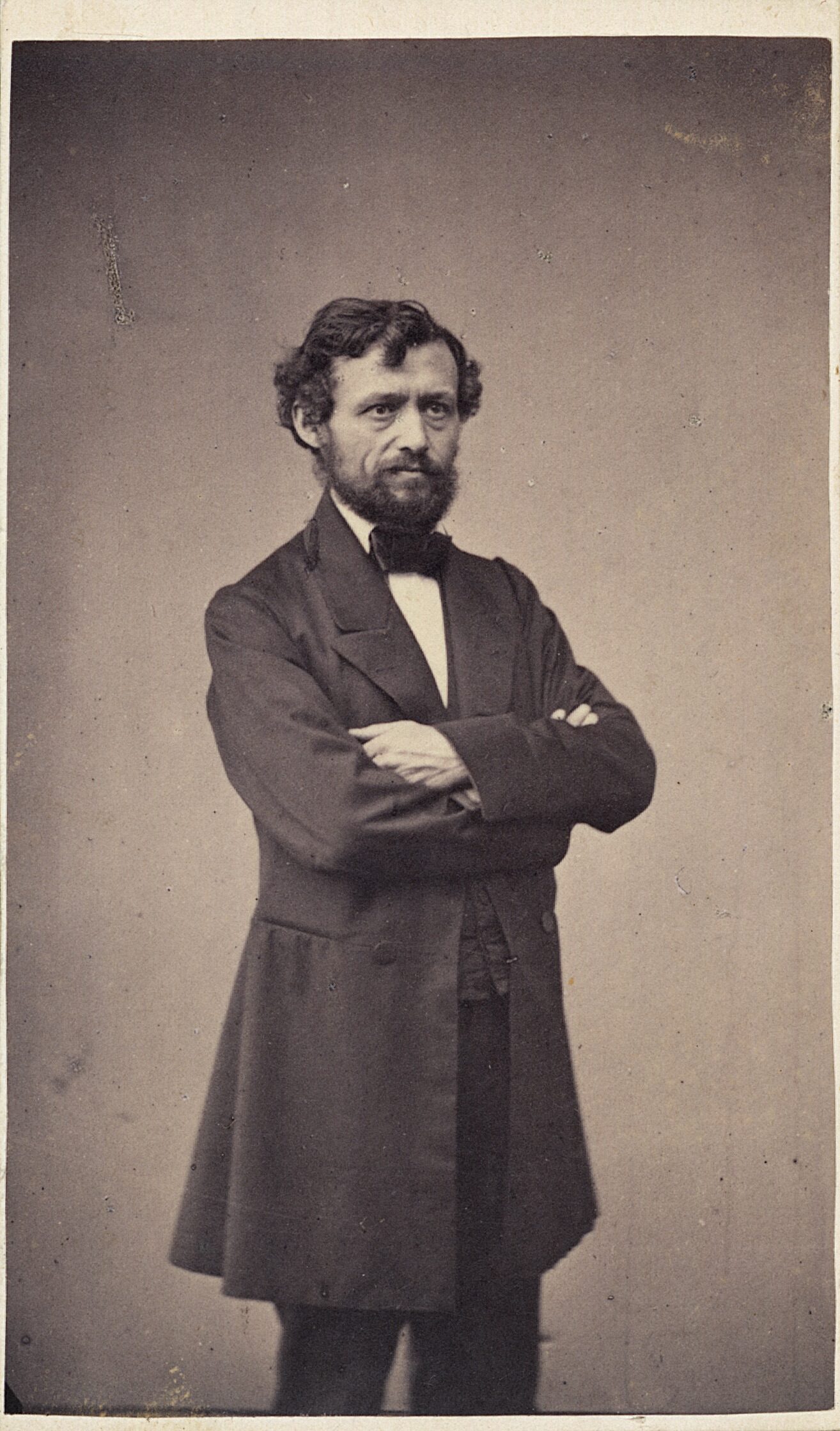
He became famous as the author of the work “The Graphic Statics” 3 , in which he presented graphic solutions for complex structural design problems that are still being used today. “‘The Graphic Statics’ represented important progress,” says Kaufmann. That is because until that time, bridge-building had been a craft based on experiential knowledge, which was passed on from generation to generation by talented builders. 4 Now, civil engineering schools in Switzerland and abroad were provided with a scientific basis, which for the first time enabled civil engineers to build bridges that matched the forces they encountered. That was especially significant for the new truss bridges made of iron or steel, which were now being built for the railway in many locations.
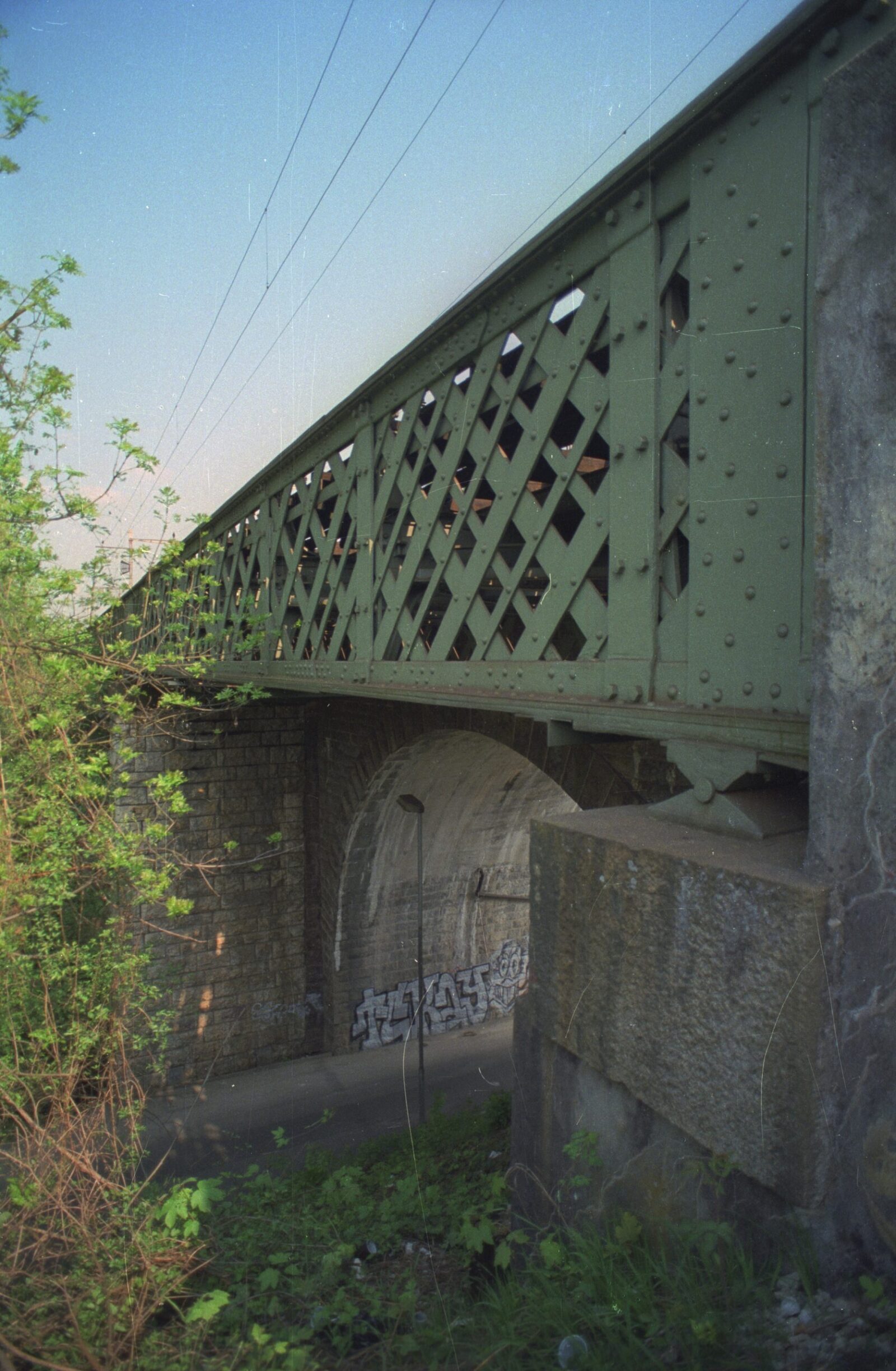
Learning from catastrophes
However, modern bridge-building was still in its infancy, resulting in a number of tragic accidents. In 1879, for example, the Tay Bridge in Scotland collapsed during a storm while a train was passing over it. 5 ' 6 The cause was determined to be a design fault, among other things. In 1891, Switzerland’s worst ever railway accident occurred: the railway bridge 7 over the river Birs near Münchenstein collapsed under the weight of a passenger train, killing more than 70 people. Two ETH professors – Wilhelm Ritter and Ludwig Tetmajer, both former students of Culmann – were commissioned to prepare a report 8 about the cause of the accident. They reached the conclusion that the bridge had design faults and that the quality of the iron used was inadequate.
Confidence in the new steel bridges and the rapid technological development was shaken. In order to improve safety and prevent similar catastrophes in the future, the Post and Railway Department issued an ordinance in 1892 concerning the calculation and testing of iron bridge and roof structures on Swiss railways. 9 All existing bridges and support structures were tested and in some cases reinforced. In addition, steel bridges were subsequently built more solidly. But because the material was expensive, this also caused costs to rise.
Back to nature
Graubünden experienced a renaissance of arched bridges made of stone. On the one hand, there were financial reasons for this: plenty of stone was available locally as a building material, and it was cheap to extract. But more important were the social movements that sought to protect the mountain landscape beauty and cultural traditions and that viewed railway bridges as unpleasant. “Glory be to stone” was the motto of Robert Moser, one of the defining engineers of the famous Albula line of the Rhaetian Railway, which was built in 1900 and, with its 135 bridges, is today a UNESCO World Heritage Site. 10 To aid in building these bridges and many others, the scaffolder Richard Coray 11 created fantastic, temporary falsework structures, which were almost more artistic than the bridges themselves.
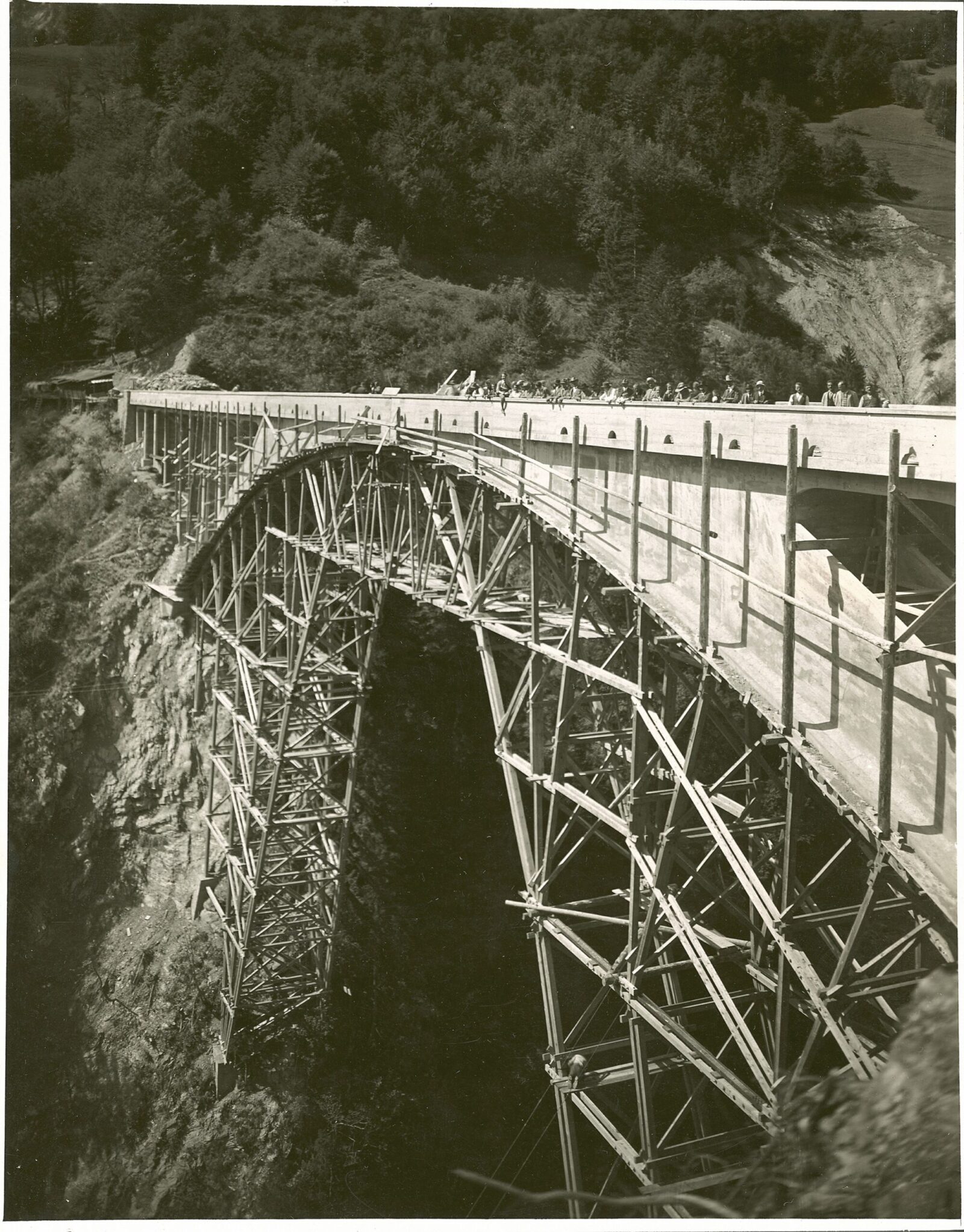
New materials and forms
In the following decades, bridge-building became more diverse, featuring the use of new materials, forms and design methods.
For instance, at the start of the 20th century, reinforced concrete 12 began to be used widely. Today, most bridges are made of it. The material was cheaper than natural stone and load-resistant, and it could be used for longer spans. Considered pioneers of Swiss bridge-building using reinforced concrete are the ETH engineers Robert Maillart 13 , whose personal papers 14 are housed at the ETH archives, and Alexandre Sarrasin. They designed extraordinarily filigree and elegant constructions, which were not only aesthetically appealing, but also efficient and sparing in their use of materials. “Maillart and Sarrasin were awarded nearly every commission that they applied for, because their bridges cost the least,” says Kaufmann. Maillart designed the Salginatobel Bridge near Schiers in the canton of Graubünden, which was completed in 1930 and is considered to be a masterpiece of engineering. Alexandre Sarrasin 15 , who worked primarily in Western Switzerland, designed the Gueuroz Bridge 16 , which was built in 1934 and at the time was the highest roadway bridge in Europe. In the mid-20th century, bridge-building saw the rise of pre-stressed concrete, a version of reinforced concrete, which enables the use of more slender bearing structures and greater distances between supports.
Symbols of progress
The civil engineer Othmar Ammann 17 , who studied at ETH from 1897 to 1902 and emigrated to the USA shortly thereafter, became famous for a completely different type of bridge. He specialised in suspension bridges, which allow much greater spans to be realised. In 1931, he set new standards with the George Washington Bridge across New York’s Hudson River – with a span of 1,067 metres, it was the world’s longest suspension bridge at the time. Ammann also served as a consultant in connection with the construction of the Golden Gate Bridge. 18 But the pinnacle of his creative achievements was the monumental Verrazzano-Narrows Bridge 19 (1964): a double-deck, 12-lane vehicle bridge spanning the tidal strait that separates the boroughs of Staten Island and Brooklyn in New York City. For his life’s work, he was awarded the coveted National Medal of Science in 1965 by U.S. President Lyndon B. Johnson personally.
“Ammann was one of the last bridge-builders to be viewed almost as a hero,” says the Swiss bridge designer Jürg Conzett, who graduated from ETH in 1980. By the time Conzett started working, the tide had turned: “The civil engineering guild had fallen into disrepute.” One reason for this was the rapid expansion of the national highway system: roads needed to be built quickly and cheaply, and in some cases, imposing structures like the Sihlhochstrasse, Zurich’s elevated motorway across the Sihl river, or sections of the Gotthard motorway were installed in the middle of the landscape without much concern for nature and aesthetics. This method of construction generated a backlash. In the mid-1980s, the renowned architect and ETH civil engineer Santiago Calatrava began to set new trends. Calatrava is known for his extravagant bridges. “The things he designed were new, crazy, artistic,” says Conzett. This led to discussions that contributed to putting greater emphasis on aesthetic aspects once again.
Elegance and lightness
But aesthetics weren’t entirely forgotten during the building boom of the 1960s and 1970s. One who remained true to this ideal was Christian Menn (1927–2018) 20 , considered one of the most important bridge-builders of the 20th century. He obtained his PhD in civil engineering from ETH in 1957, where he later worked as a professor of structural engineering. He designed more than 100 bridges in Switzerland and abroad, including many motorway bridges. Some of them are reminiscent of the designs of Robert Maillart, such as the Cascella Bridge along the San Bernardino route. Others feature a completely different style, like the 678-metre-long Ganter Bridge at the foot of the Simplon Pass. It garnered worldwide attention and was praised for its bold design, although its dominant appearance also prompted criticism. Perhaps that is the very reason why it is considered one of the few bridge landmarks in Switzerland. Menn himself once said in an interview: 21 “The art of engineering also consists of building something in a way that stuns laypeople through elegance and lightness.” He certainly achieved that with the Sunniberg Bridge near Klosters in the canton of Graubünden, which received several international awards.
Careful treatment of the landscape was of fundamental importance to Menn. “That attitude still characterises Swiss building culture to this day,” believes Jürg Conzett. For his part, he also pays particular attention to the historical and cultural heritage in connection with his projects: for example, he is currently rebuilding three bridges in the village of Bondo, located in the Bregaglia Valley in the canton of Graubünden, that were destroyed by a mudslide. Although they feature modern concrete construction, their curved forms recall and continue the tradition of stone-arch bridges in the Bregaglia Valley. Conzett has also repaired many historical stone bridges of the Rhaetian Railway in the canton of Graubünden, as well as several reinforced-concrete bridges designed by Robert Maillart.
Bridge maintenance – a never-ending task
Historical structures are not alone in needing care – the maintenance of more recent roadway bridges is also a never-ending task. ETH also does its part in this regard. “While maintenance may be much less spectacular than building new bridges, it is much more relevant,” says Kaufmann. He prepares studies for the Swiss Federal Roads Office and recalculates statics for existing bridges using modern methods in order to verify their load-bearing capacity. At the ETH laboratory for experimental research (Bauhalle) 22 on the Hönggerberg campus, his research group tests the strength of concrete elements, including with the use of enormous hydraulic presses. The aim of Kaufmann’s research is to ensure that bridges are repaired or strengthened only when this is truly necessary, which can enable massive cost savings. This objective is also being pursued by Eleni Chatzi, Professor of Structural Mechanics and Monitoring at ETH. With the aid of sensors and automated data analysis, she monitors the condition of bridges in order to identify critical structural locations and target them for repair.
Designing the future
Although new bridges continue to be constructed in Switzerland, most are now built abroad, particularly in Asia. Structures with unimaginable dimensions are being created there, such as the Danyang-Kunshan Grand Bridge 23 in China, a 164-kilometre-long railway viaduct that is currently the longest bridge in the world. Many of the monumental bridges are cable-stayed bridges, since this allows large distances of more than one kilometre to be spanned very efficiently. 24 The development of this type of bridge is still ongoing. Experiments are also being conducted with ultra-high strength concrete, which promises greater durability. Apart from this, however, Kaufmann does not expect any groundbreaking innovations: “We will not be seeing any completely new materials or technologies in the coming years.” Jürg Conzett agrees. He believes that enhancements will mainly focus on design elements. Regardless of the direction the future may take, gems worth discovering will continue to be created – thanks in no small part to Swiss bridge-builders.
Footnotes
- Bridge structures more than six metres in length, according to information provided verbally by Walter Kaufmann. ↩︎
- research-collection.ethz.ch/handle/20.500.11850/23268?locale-attribute=en ↩︎
- doi.org/10.3931/e-rara-20052 ↩︎
- They include the Grubenmann brothers, who were members of a family of carpenters from Teufen in the canton of Appenzell Ausserrhoden and built bridges and churches in the 18th century, primarily in Eastern Switzerland. Only a few of these wooden bridges survived; most were destroyed. ↩︎
- https://en.wikipedia.org/wiki/Tay_Bridge_disaster ↩︎
- Theodor Fontane memorialised the accident in his poem “Die Brück’ am Tay”. ↩︎
- The bridge had been built by the company Eiffel et Cie, one of whose founders, Alexandre Gustave Eiffel, built the Eiffel Tower. ↩︎
- e-periodica.ch/digbib/view?pid=sbz-002:1891:17::1992#1992 ↩︎
- e-periodica.ch/digbib/view?pid=sbz-002%3A1892%3A19%3A%3A889#1596 ↩︎
- rhb.ch/fileadmin/user_upload/redaktion/Ueber_die_RhB/UNESCO%20Welterbe/Dokumente/Kandidaturdossier/Deutsch/2a4_de.pdf ↩︎
- eth.swisscovery.slsp.ch/discovery/fulldisplay?docid=alma99117425090305503&context=L&vid=41SLSP_ETH:ETH&lang=en&search_scope=DiscoveryNetwork&adaptor=Local%20Search%20Engine&tab=discovery_network&query=any,contains,Richard%20coray&facet=tlevel,include,online_resources&offset=0 ↩︎
- Concrete reinforced with rebar inside. ↩︎
- library.ethz.ch/en/locations-and-media/platforms/short-portraits/robert-maillart-1872-1940.html ↩︎
- doi.org/10.3929/ethz-a-000619728 ↩︎
- hls-dhs-dss.ch/de/articles/031655/2015-04-20/ ↩︎
- e-periodica.ch/digbib/view?pid=bts-002%3A1934%3A60%3A%3A1458&referrer=search#1458 ↩︎
- blogs.ethz.ch/digital-collections/en/2019/07/05/von-einem-der-auszog-den-brueckenbau-zu-revolutionieren-teil-i/ ↩︎
- blogs.ethz.ch/digital-collections/en/2012/04/06/wie-viel-schweiz-steckt-in-san-francisco-der-bauingenieur-o-h-ammann-und-die-golden-gate-bridge/ ↩︎
- blogs.ethz.ch/digital-collections/en/2019/09/27/othmar-ammann-und-seine-bruecken-teil-ii/ ↩︎
- ethz.ch/en/news-and-events/eth-news/news/2018/07/bridge-builder-christian-menn-dies.html ↩︎
- espazium.ch/de/aktuelles/gleichgewicht-ist-einer-der-schoensten-begriffe ↩︎
- ibk.ethz.ch/research/ResearchFT.html ↩︎
- https://en.wikipedia.org/wiki/List_of_longest_bridges ↩︎
- Comment by Walter Kaufmann: Suspension bridges are still able to span the greatest distances, such as the Çanakkale 1915 Bridge currently being constructed across the Dardanelles strait in Turkey, with a record span of 2,023 metres. The longest distance spanned by a cable-stayed bridge is currently 1,104 metres (Russky Bridge in Vladivostok, Russia), although somewhat more is certainly possible. Cable-stayed bridges are successful particularly because they can be built without falsework and are thus very economical. Although suspension bridges also do not require falsework, the cables need to be built before work can start on the superstructure – which takes longer and is more expensive in comparison to a cable-stayed bridge, where cables and superstructure are built at the same time. ↩︎
